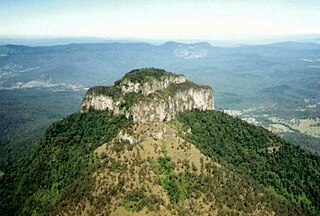| Cyathea grevilleana | |
|---|---|
| Scientific classification | |
| Kingdom: | Plantae |
| Division: | Pteridophyta |
| Class: | Pteridopsida |
| Order: | Cyatheales |
| Family: | Cyatheaceae |
| Genus: | Cyathea |
| Subgenus: | Cyathea |
| Section: | Alsophila |
| Species: | C. grevilleana |
| Binomial name | |
| Cyathea grevilleana Martius, 1834 | |
| Synonyms | |
| |
Cyathea grevilleana is a species of tree fern endemic to Jamaica, where it grows in moist gullies and on wooded hills in both calcareous and noncalcareous soils at an altitude of 200–1200 m. The trunk of this plant is erect, about 7 m tall, and 10–15 cm in diameter. It is characteristically clothed in old stipe bases, brown scales and blackish spines. Fronds are tripinnate, dark green in colour, and up to 4 m in length. The last pinnae are sometimes separated, forming a distinctive clump around the trunk apex. The rachis is yellow-brown and almost smooth. This species has a long, dark brown stipe with a few scattered spines. Sori are produced in four to six pairs along the pinnule midvein. They are protected by pale brown indusia that are cup-like in appearance.

The order Cyatheales, which includes the tree ferns, is a taxonomic division of the fern class, Polypodiopsida. No clear morphological features characterize all of the Cyatheales, but DNA sequence data indicate the order is monophyletic. Some species in the Cyatheales have tree-like growth forms, but others have rhizomes.

Jamaica is an island country situated in the Caribbean Sea. Spanning 10,990 square kilometres (4,240 sq mi) in area, it is the third-largest island of the Greater Antilles and the fourth-largest island country in the Caribbean. Jamaica lies about 145 kilometres (90 mi) south of Cuba, and 191 kilometres (119 mi) west of Hispaniola.

In botany, a stipe is a stalk that supports some other structure. The precise meaning is different depending on which taxonomic group is being described.
C. grevilleana forms part of the complex centered on Cyathea woodwardioides comprising six very similar taxa from the Greater Antilles. The other five species are Cyathea crassa , Cyathea fulgens , Cyathea portoricensis and Cyathea tussacii . Large and Braggins (2004) note that this group is known to cross with members of the Cyathea minor complex.

In biology, a taxon is a group of one or more populations of an organism or organisms seen by taxonomists to form a unit. Although neither is required, a taxon is usually known by a particular name and given a particular ranking, especially if and when it is accepted or becomes established. It is not uncommon, however, for taxonomists to remain at odds over what belongs to a taxon and the criteria used for inclusion. If a taxon is given a formal scientific name, its use is then governed by one of the nomenclature codes specifying which scientific name is correct for a particular grouping.

The Greater Antilles is a grouping of the larger islands in the Caribbean Sea: Cuba, Hispaniola, Puerto Rico, Jamaica, and the Cayman Islands.
Cyathea crassa is a species of tree fern endemic to the Santo Domingo area in the Dominican Republic. Little is known about this rare tree fern.
Cyathea lindsayana was described by William J. Hooker in 1865 based on material that was recorded as having originated from Mount Lindesay in Queensland. Tindale (1956) concluded that this taxon is conspecific with C. grevilleana and thus should be considered a junior synonym. Large and Braggins suggest Hooker's naming of a new species identical to one published had likely been an error and the result of samples being mixed up.

Mount Lindesay is a mountain and locality within the Scenic Rim Region, Queensland, Australia.

Queensland is the second-largest and third-most populous state in the Commonwealth of Australia. Situated in the north-east of the country, it is bordered by the Northern Territory, South Australia and New South Wales to the west, south-west and south respectively. To the east, Queensland is bordered by the Coral Sea and Pacific Ocean. To its north is the Torres Strait, with Papua New Guinea located less than 200 km across it from the mainland. The state is the world's sixth-largest sub-national entity, with an area of 1,852,642 square kilometres (715,309 sq mi).
The specific epithet grevilleana commemorates Robert Kaye Greville (1794-1866), who collected the type specimen in Jamaica in 1832.
An epithet is a byname, or a descriptive term, accompanying or occurring in place of a name and having entered common usage. It has various shades of meaning when applied to seemingly real or fictitious people, divinities, objects, and binomial nomenclature. It can also be a descriptive title: for example, Pallas Athena, Alfred the Great, Suleiman the Magnificent or Władysław I the Elbow-high.

Dr Robert Kaye Greville FRSE FLS LLD was an English mycologist, bryologist, and botanist. He was an accomplished artist and illustrator of natural history. In addition to art and science he was interested in causes like abolitionism, capital punishment, keeping Sunday special and the temperance movement. He has a mountain in Queensland named after him.

A holotype is a single physical example of an organism, known to have been used when the species was formally described. It is either the single such physical example or one of several such, but explicitly designated as the holotype. Under the International Code of Zoological Nomenclature (ICZN), a holotype is one of several kinds of name-bearing types. In the International Code of Nomenclature for algae, fungi, and plants (ICN) and ICZN the definitions of types are similar in intent but not identical in terminology or underlying concept.
